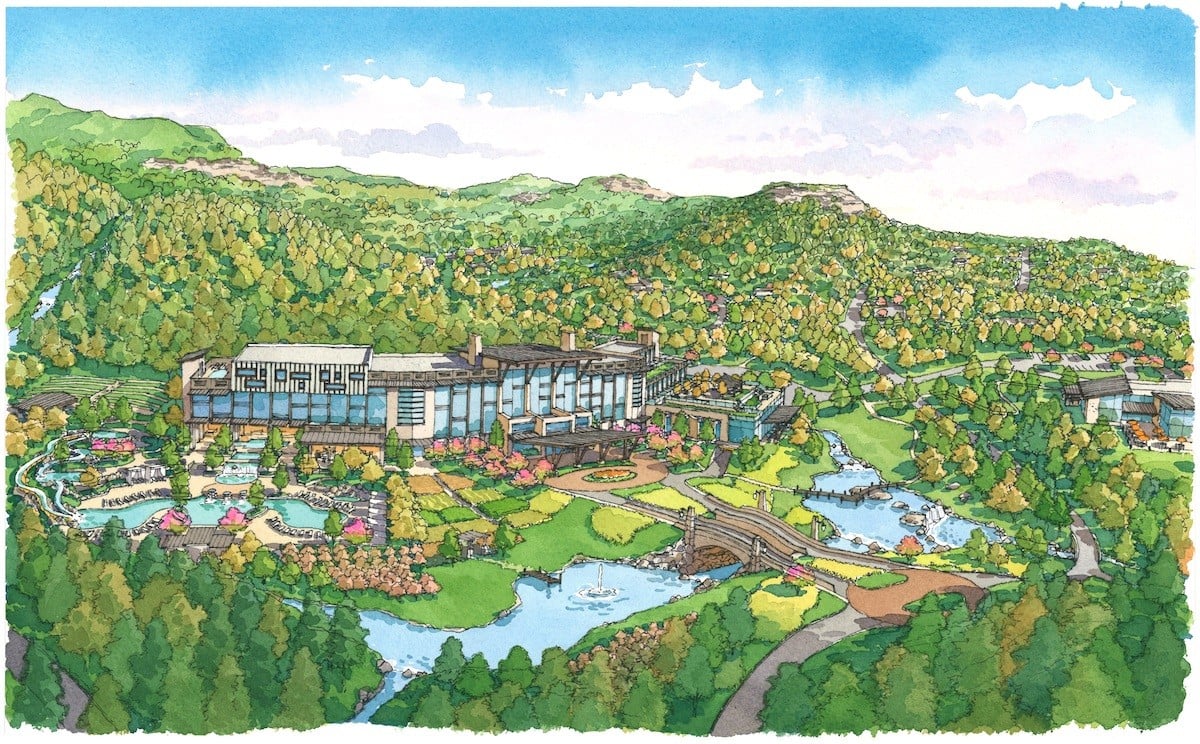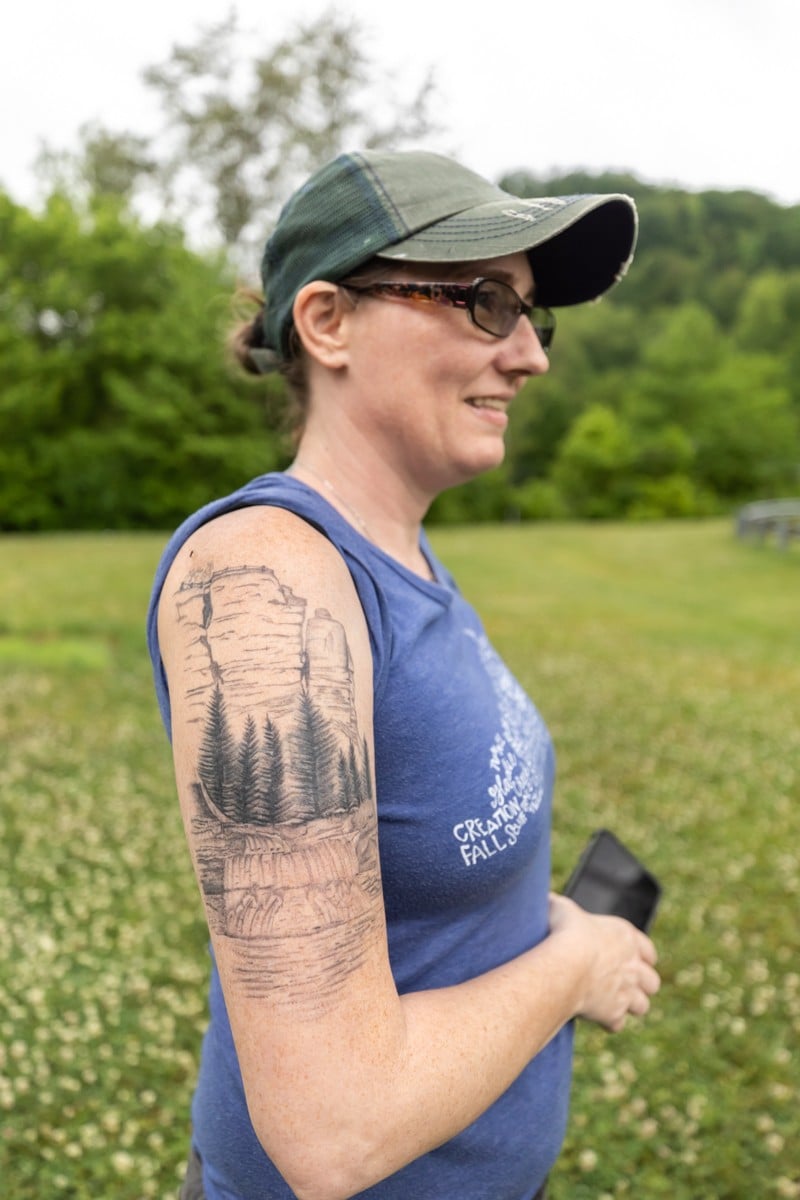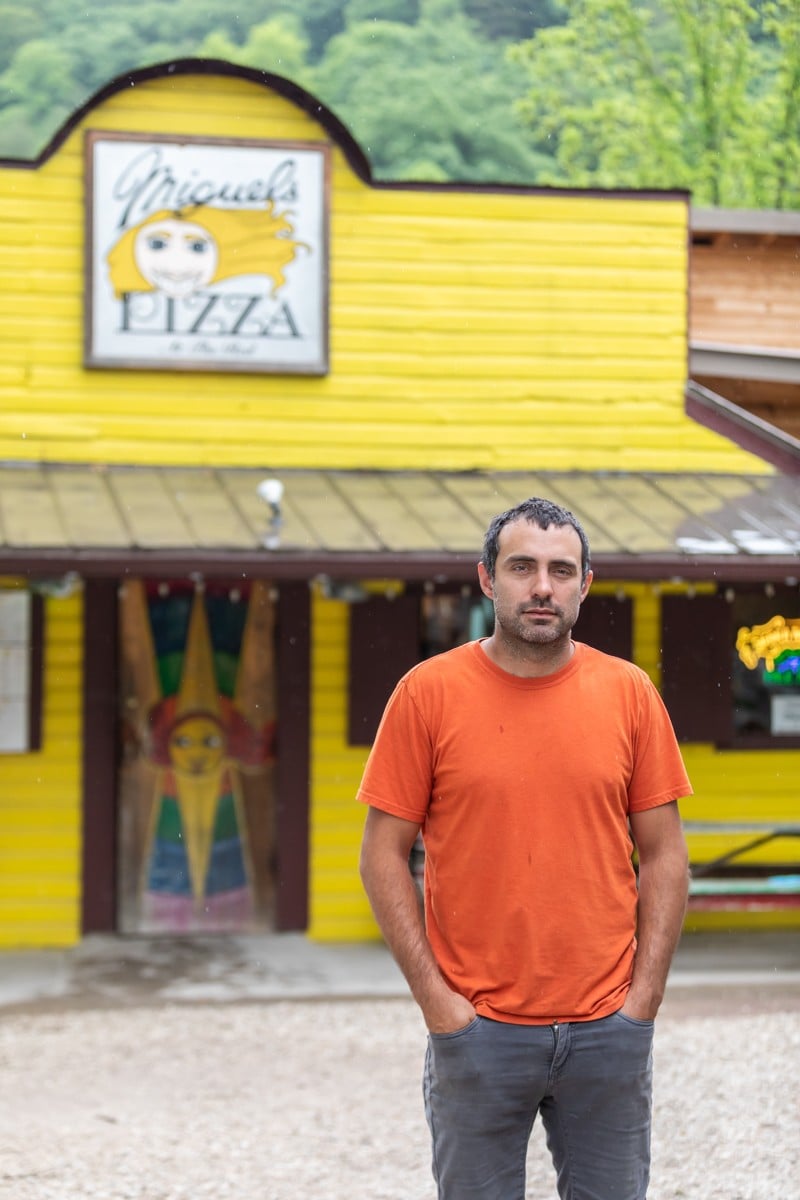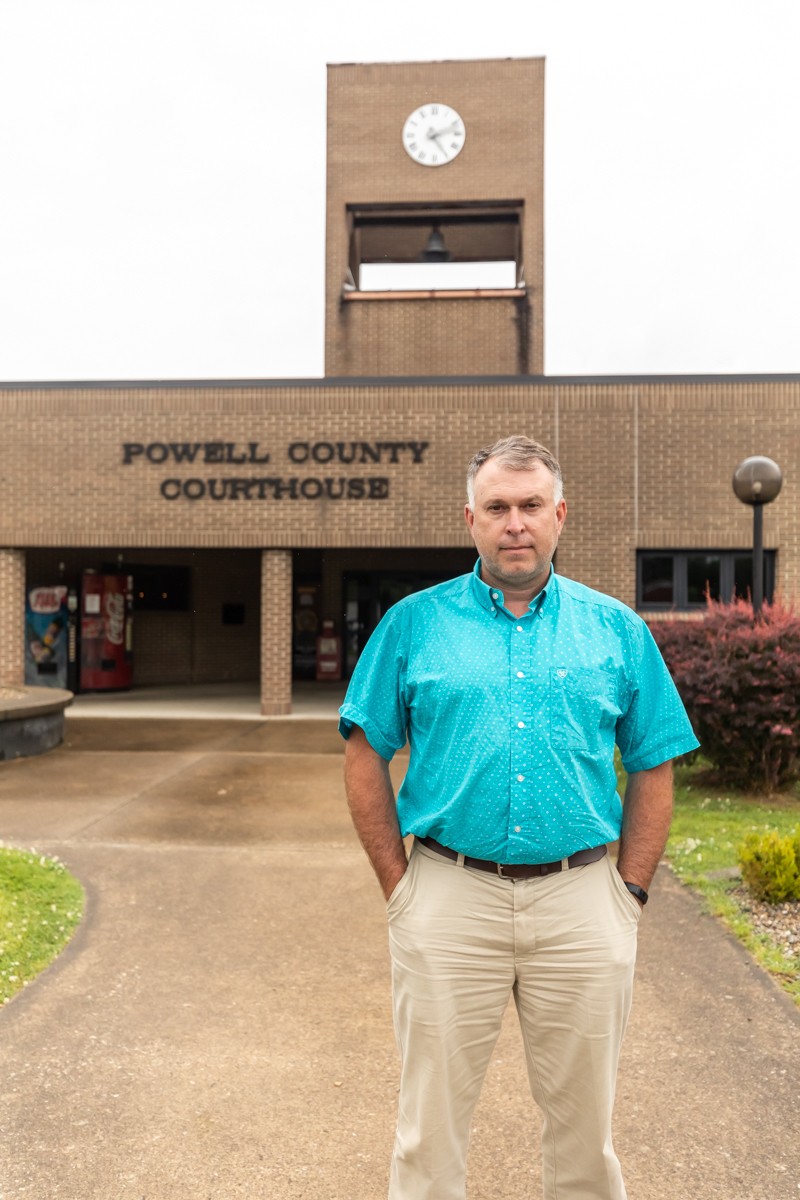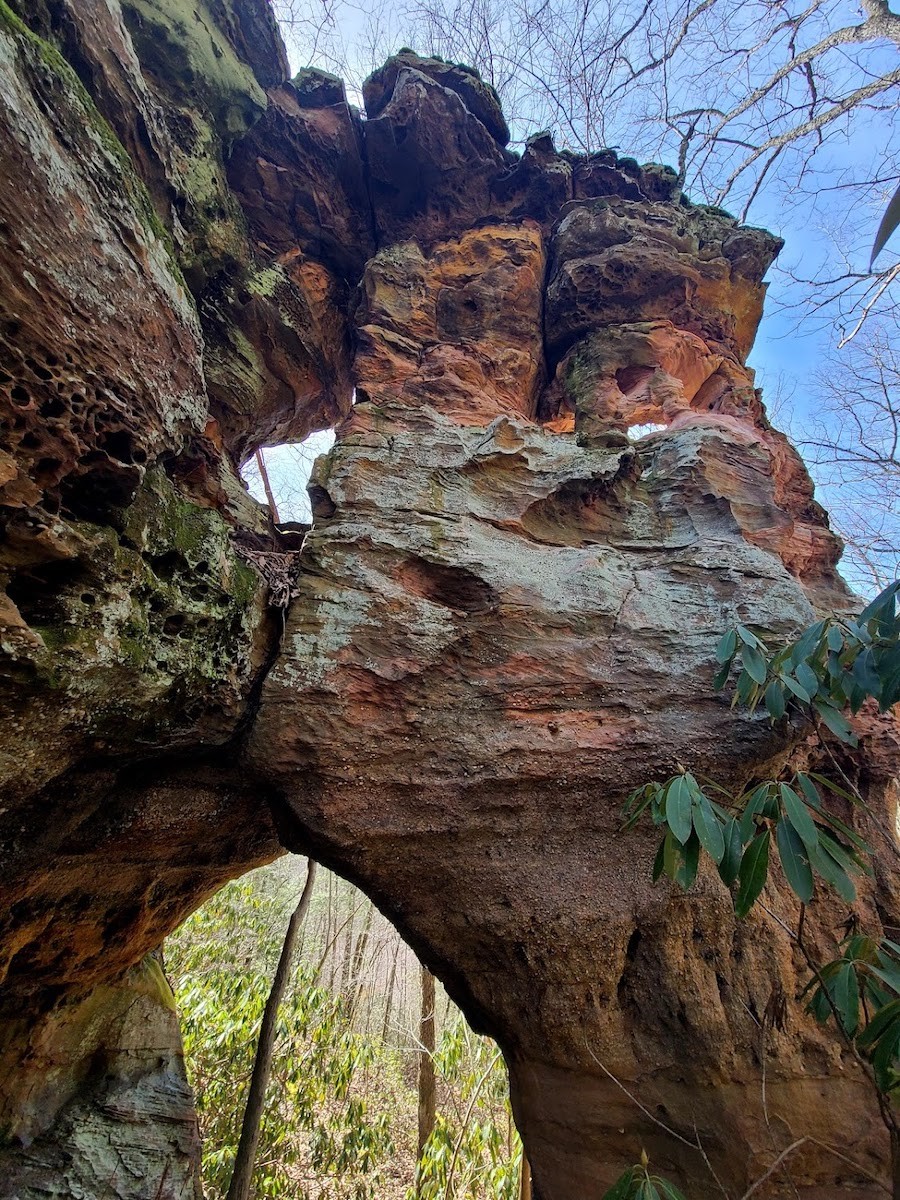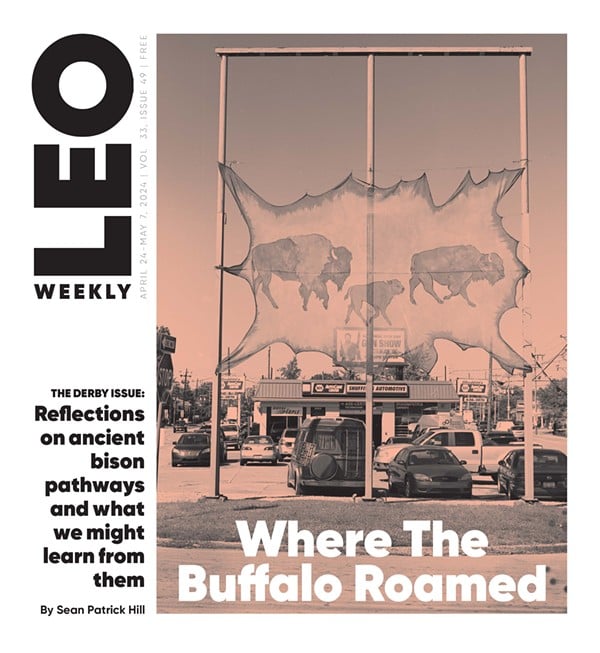Christie Abrams had a problem. And like many of the climbers, hikers and other outdoor enthusiasts who live in the Red River Gorge area, she works out her issues in the wilderness.
The cause of her consternation was a $135 million luxury resort with 170 rooms planned for the Gorge: a climbing and outdoor mecca currently served mostly by small, “mom and pop”-style businesses located in Eastern Kentucky, a little over two hours away from Louisville. At the beginning of the pandemic, to grapple with the idea of a large development in her tree-lined sanctuary, Abrams would drive to the site of the proposed resort: 891 acres of undeveloped land directly off a state highway, with cliffs and more than 20 natural arches.
Abrams typically leads tours on the property through her ecotourism business, Leave No Trace Adventures. But, in these moments, she’d go alone.
There, in a meadow deep into the property, where a lodge, distillery, spa and more are planned, Abrams would walk through the grass and commune with the land. As she listened to the crickets and searched for the heartbeat of the land with her bare feet, she found its voice, she said, and how she thinks it feels about the development.
“It says ‘Yes, we definitely want [people] to be here. That’s why I’m so beautiful,’” said Abrams. “‘But at the same time, I don’t want to be destroyed because of my beauty. I don’t want to be loved to death.’ The same thing that the Gorge is screaming, you know? ‘I don’t want to be loved to death.’”
The Red River Gorge is a geological gem in Eastern Kentucky, with over 100 natural arches and world-famous rock climbing. In more recent years, zip lining and underground kayaking have popped up as options for visitors.
The area used to be a hidden wonder, say longtime residents and business owners. They started ventures anyway, like the famous Miguel’s Pizza, valuing the land for its natural beauty and small town atmosphere. In the past seven or so years, the Gorge has been discovered by the masses, leading to new businesses and success for existing ones. An estimated 750,000 people per year now visit the area. But, the Gorge is straining in some ways under the weight of its own growth: roads are congested with tourist traffic, water systems are almost at capacity and a cabin-building boom has led to some being constructed along ecologically precious cliff line.
Some residents worry that the extra 75,000 to 85,000 people a year that the resort hotel is projected to attract will push the area to its limit. It started as an economic development project by the Kentucky Chamber of Commerce. When it went public, a group of concerned citizens organized to oppose it, Red River Gorge United. But as the resort plan solidifies, the collective is now focused on monitoring the project — making sure it looks like the released plan and managing the growth that will follow it. It’s a task with significant challenges, given that its home county does not have its own zoning or building code and the future developer is unknown. But, the minds behind the resort say that their project has kicked off a much-needed discussion about how to shape the economic future of the already blossoming Gorge.
Abrams, meanwhile, has changed her mind about the resort after her conversations with nature. At first, she was angered by the idea, but now, she’s found herself in the middle, with one part of her (the director of Wolfe County Tourism) praising the prospect of increased visitorship and the other (the eco-friendly tour guide) worrying about keeping the Gorge pristine. “When I actually got to see the meat and bones of where the project was and the people behind the project and what they have in play and getting to know them the way that I do, it’s moved me to that 50/50 slot, because I can see where it can be beneficial. But at the same time, I see how business plans can fail,” she said.
A LUXURY RESORT AND A PLAN TO SAVE EASTERN KENTUCKY
A master plan for the Red River Gorge resort, revealed last fall, describes it as the ideal destination for “the modern adventurer who enjoys a little bit of luxury.” Think of it as what The Greenbrier is to West Virginia or French Lick Resort to Indiana.The plans include the lodge with its 170 rooms, as well as 10 resort cottages, a “destination spa,” conference facility, two restaurants, retail space, a fitness center, a distillery and/or microbrewery, an indoor/outdoor pool, a wedding venue, an outdoor event space, parking below the lodge and a “Founder’s Lane” with vacation home lots for sale. It suggests other amenities that aren’t included in the “current program,” such as a permaculture garden and orchard, glamping, an equestrian center and another remote event center for larger gatherings.
While large, the master plan only calls for the resort to take up less than 10% of the 891 acre property. In the unused reaches of the property, a nature preserve and public hiking trails are proposed. The resort itself will be nestled deep into the property — not visible from the outside. To address ecological concerns from a local advisory board, the plan calls for no development within 20-feet of the property’s cliff line and complying with International Dark-Sky Association lighting guidelines to minimize light pollution. And, resort planners claim that the lodge’s offerings are so comprehensive that visitors will stay on the property for the majority of their trip — easing the strain on the Gorge.
The resort is part of a broader tourism strategy for the four-county Gorge area: Lee, Menifee, Wolfe and Powell County (where it is actually located) and promotes other projects, including a shuttle system for visitors to explore the area with.
The resort plan has been crafted to cater to a clientele that can afford to spend $350 a night on a hotel room, but the idea itself started with the intention of helping an Eastern Kentucky hurting economically from the decline of coal. In 2013, the Kentucky Chamber of Commerce first started studying a solution by creating a task force.
“We were in 2013, we were still coming out of a major recession … And so a lot of people were leaving Eastern Kentucky, jobs were not available, and the economy was suffering,” said Dave Adkisson, the former president of the Kentucky Chamber who is now retired and a member of the holding group that bought the resort property.
The task force quickly focused on bringing a tourism lodestar to the region. Ideas included casinos, outlet malls, water parks and entertainment venues. With the help of a study, it narrowed its scope to a resort concept in the Red River Gorge, with an eye on the property that the holding company now owns.
The Gorge was chosen for its proximity to major metro areas, its positive brand as a hub for young adventurers and because it’s a “natural gateway” to the rest of Eastern Kentucky, said Adkisson.
It wasn’t until 2019, however, after securing an option on the land and receiving a federal grant of $500,000 with state matching funds to commission a final study, that the Chamber – now through a nonprofit arm called Red River Economic Development — held its first public forum on the project. The group is made up of bankers and businesspeople from Eastern Kentucky and four county judge executives that were added in 2018 when the nonprofit was created.
“…until we had the federal grant approved, we didn’t know whether we had a project or just a pipedream,” wrote Adkisson in an email. “If we had gone public before that meeting, it could have easily cost us the grant and therefore, killed the idea of a destination resort before it ever became a project.”
A firm called Stantec completed the final study for the resort, resulting in the master plan and a recommendation that the project be located on the 891 acres, now owned by local entrepreneur Ian Teal.
This April, a holding company, Red River Property Holding Group LLC — made up of at least two bankers who resigned from RRED and Adkisson — bought the resort property for $2.9 million. Teal is also a member of the holding group. According to Adkisson, Teal will write a check to the LLC for his own share, making him a minority partner, and then the LLC will write Teal a check for the property. The group has three years to find a resort developer. If not, they’ll try and sell the property to someone else.
Local business owners in the heart of the Gorge have accepted that the resort is likely coming, but there are still some concerns about whether it’s the best fit for the area and questions as to why they weren’t informed earlier.
Dario Ventura’s family started Miguel’s Pizza, which began as an ice cream shop in 1983. He said he sees pros and cons to the resort, but he wishes developers had gone with a different idea. Ventura joined a board made up of locals that gave input on the project. The local advisory board was created in 2020. Ventura hoped to help guide the project in a new direction that would be good for the area.
“I don’t think that really happened,” he said.
The luxury resort doesn’t cater to the type of person who is naturally drawn to the Gorge — people who spend their time outdoors, he said. Ventura thinks a music venue, like the Red Rocks Amphitheatre near Denver, would have been a better fit — something that didn’t attract traffic daily and that followed the Eastern Kentucky tradition of country and folk music. But, RRED didn’t waver from its original resort concept.
The resort plan doesn’t fit in with the other small, Gorge businesses either, said Nancy Hamann, a member of Red River Gorge United and the local advisory board.
“That’s what RRGU supports,” she said. “Natural, organic, small business growth helps people that can make a living, versus a big resort is going to be owned by out-of-state investors. Investor-owned, corporate-owned — a few are going to make a ton of money.”
Ventura also questioned why the Chamber would focus on economic development in the Gorge area, which is already growing, rather than in other parts of Eastern Kentucky that might need more help. Hamann, who also owns the Daniel Boone Coffee Shop in Slade, as well as Scenic Cabin Rentals, pointed out that Powell County isn’t historically a coal industry area. But, the Gorge does have its economic struggles.
Powell County, where the resort will be located, had an unemployment rate of 3.9% in April — lower than the state’s 4.7%. But, 56% to 70% of Powell County residents commute outside of the area for work, said Powell County Judge Executive James Anderson.
“Every kid that graduates high school here should have the opportunity if they choose to be able to come back home and work,” said Anderson. “That historically has not been the case.”
The resort is expected to generate 325 jobs on site at an average annual salary of $33,620, with some higher paying positions such as managers and distillery employees. And, it’s expected to generate 177 more jobs in the area as a whole to support the growth.
Anderson said that he thinks most of the “true residents” of the area, those whose kids go to school there and work there, are “very open” to the resort. Like Bobby Lowe, who said he’s lived in Stanton, Kentucky — a town 15 minutes away from the proposed resort — for 35 to 40 years.
“I’d love for it to happen. Any income in this area would help,” he said. “The town has died a lot in a lot of ways. And all the kids that have graduated in the last 40 years, I don’t know where they’re at. What I’m saying is, there’s no jobs here at home.”
Anderson, who was elected in 2011, said, overall, Red River Economic Development’s business members have placated the majority of the concerns he’s had about the resort.
“Negativity is what people want, you know, like some conspiracy, and I really don’t view it that way,” he said. “I think everybody wants to see the devil, and that’s not the case. I think it’s a genuine effort from these people. Or, their reasons truly were for the betterment of Eastern Kentucky.”
SMALL BEGINNINGS, THEN A BOOM
While Ventura doesn’t think the resort is necessarily the best fit for the Gorge, growth for the area is something that his family has always hoped for.When his father and mother, Miguel and Susan Ventura, bought their property just up the road from the Natural Bridge State Park, it was “a pretty desolate zone,” he said. But, it was inexpensive land — the Venturas and a few of their “hippie friends” were able to purchase 60 acres for around $50,000, he continued.
At the time, the state park attracted some tourism to the Gorge, but not much. The Venturas started the ice cream shop and a $2 a night climbing campsite. The ice cream shop became a pizzeria and the campsite has stayed.
Dario Ventura remembers being the same age his daughter Cedar is now, running around the property and talking to the climbers who were camping for the night. Dan Dourson, a retired U.S. Forest Service ranger who moved to the area in the ‘70s, said he and a few other residents and climbers were often the only customers who ate at Miguel’s in the beginning.
Dan and his wife Judy Dourson came to the Gorge from Ohio; Hamann arrived from Cincinnati 11 years ago; and the Venturas relocated from Connecticut — all persuaded to stay by untamed, beautiful land. It’s a familiar story for long-time transplants, including Abrams. She came from Rock Castle, Kentucky 11 years ago and decided to stay after her first hike in Daniel Boone Forest. “It’s just like sitting in church,” she said.
Judy Dourson, a retired school teacher, and Dan Dourson, watched as Miguel’s attracted more climbers to the area. Over the years, other tourists drawn to the outdoors followed.
Entrepreneurs responded to the growth, but mostly independent ones, according to Ventura.
“Everything that’s kind of opened has filled like a new avenue, and it’s original and brings, like, a different aspect to the area,” he said. “And that’s what makes this place cool. You’re not going to the same chain restaurant everything, you know what I’m saying?”
What started as a steady trickle of new visitors has turned into a flood.
The Doursons moved to Belize 12 years ago. When they returned five years ago, the Gorge was totally transformed.
“Now, I mean, it’s insane to go there on the weekends; we never go there on the weekends,” said Dan Dourson.
Ventura said the Gorge’s growth spurt started around seven years ago, he thinks, because of an increased focus on Kentucky tourism and other publicity. For a time, he said, he was participating in some sort of interview every weekend. The rise of social media has played a role, too. He often sees people pull up to Miguel’s to take a picture in front of it rather than eat.
“It’s, like, cool to go be outside now,” he said.
The Doursons said they’ve seen hiking grow in popularity and gas prices lower so people from nearby cities are more willing to take a trip to the Gorge.
The pandemic brought even more visitors, including people who decided to work remotely at the Gorge instead of staying chained to their computers at home.
Miguel’s has swelled with the new business. Ten years ago, the Venturas added a shelter house for outdoor dining and another building that functions as a meditation room and bathhouse for campers. The family used to expand their main, signature yellow-faced building as needed, essentially nailing storage sheds together, said Dario Ventura. Three years ago, during their annual winter-months closure, the Venturas tore the additions down and built a more open upper floor area in its place and renovated the basement. They’ve started to move beyond Miguel’s, too. Dario Ventura is now working on a totally new restaurant: a sit-down barbecue concept on 100 acres of land, which will also include areas for hiking and fishing.
“I mean, on our end, it’s great for business,” said Ventura about the Gorge’s growth. “We’re always expanding and keeping up.”
There are downfalls, however.
“I feel like a lot of people felt like this was, like, their little secret, the Red River Gorge, you know. It’s definitely not the case anymore,” he said.
And, there is a “wear and tear” on the natural environment that needs to be figured out, he said.
WEAR AND TEAR
Dan Dourson’s time in the Forest Service in the Gorge was devoted to protecting and cultivating its diverse wildlife.He retired in the ‘90s amid budget cuts, but today his life is still devoted to honoring the ecological sanctity of the Gorge by writing guidebooks with Judy Dourson, who was also a member of the local advisory board.
From his vantage point, the Gorge is at capacity. Any more people, and the precious plants and animals that live hardly anywhere else in the world but the Gorge could start to disappear. Powell County is home to eight endangered species of animals, including the Virginia big-eared bat. Around 95% of the bat’s world population is split between the Gorge and an area of West Virginia, Dourson said. During the summer, the bats raise their young in the sandstone shelters that dot the Gorge. One curious hiker intruding on their home can cause a colony to relocate, often to a less suitable location.
In the Gorge’s river, there were 29 different species of rare freshwater mussels. Already, canoeing during dryer seasons has contributed to the disappearance of 14 of those species, said Dourson.
The three most sensitive areas in the Gorge, said Dourson, are its cliff lines, limestone caves and its river, according to Dourson. And the cliff lines have been endangered by the area’s cabin building boom. In Powell County, there are no local planning and zoning or building laws, and with that — no way to keep property owners from building along the cliffs.
The Doursons have also noticed the infrastructure issues that have arrived with more visitors. When they moved back from Belize, they returned to their home near the Nada Tunnel. But soon after, they had to find a different place to live because of new, loud traffic noises and long lines to get into the one-way tunnel road that serves two-way traffic. Local business owners have identified other congested areas, as well as a lack of parking within the Daniel Boone National Forest.
Meanwhile, basic services in the area are seeing signs of strain, and there are worries that more visitors could cause greater problems.
Hamann said garbage from visitors has increased at her coffee shop with more tourists. Fees have gone up and she’s had to buy another dumpster. In Wolfe County, there is no public trash pickup, said April Reefer, the owner of a restaurant in the area called Hop’s.
Water access is strained, as well. An infrastructure report from Stantec says that the waste and wastewater plants within the four-county Gorge region “are mostly depleted of excess available capacity” and “many are either nearing or already beyond the permitted design capacity.” Reefer said that the local government refused to expand a water line to the rest of her property, citing low water pressure. She had to run her own water line and set up her own sewer system.
“That’s a challenge for running a business when you can’t have — I mean those are pretty basic things: water, septic and trash,” she said.
There are concerns that resort visitors will make these problems worse, but Adkisson also argues that the project could attract more investment in public infrastructure — and promote local growth management.
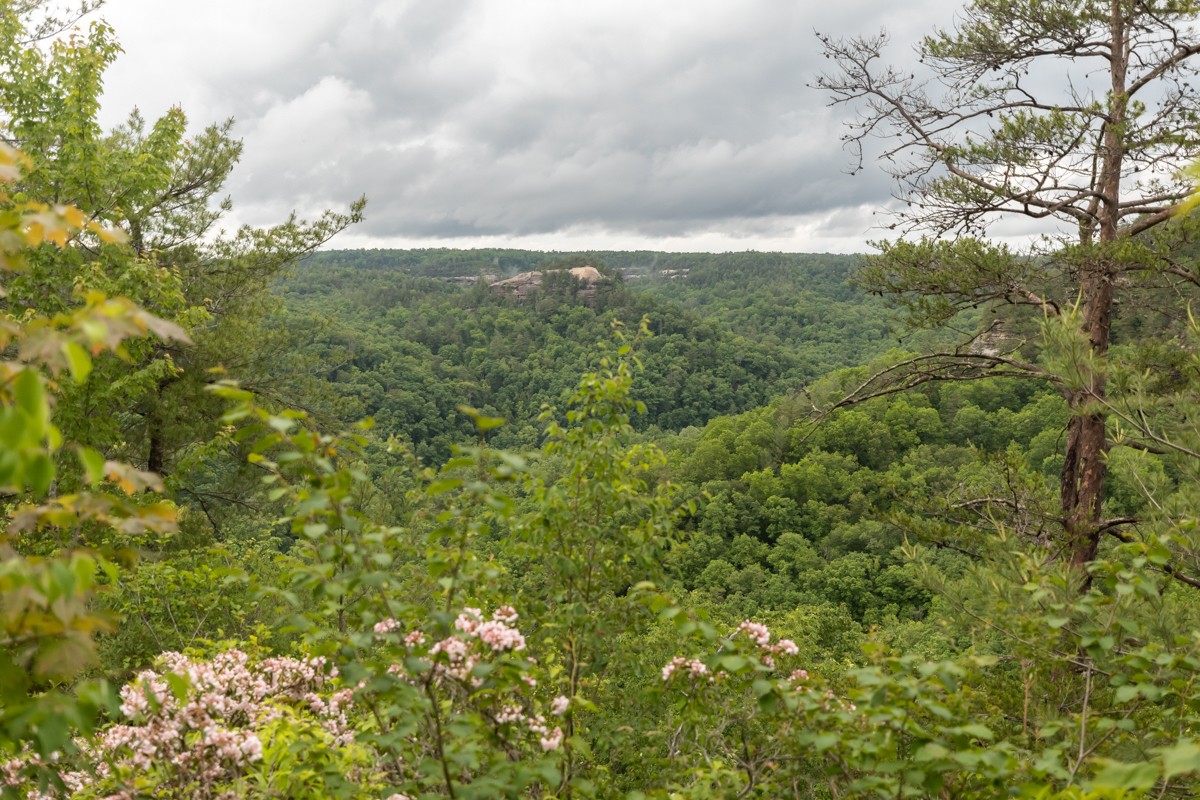
MEETING AND MOLDING THE GROWTH
Powell County residents have traditionally resisted the idea of zoning laws, said County Judge Executive Anderson. As Ventura put it, “Kentucky people, they want to do what they want to do.”But, the Gorge’s recent growth has caused some residents to realize the value in regulating some types of development, said Anderson.
Now, there is growing support for creating zoning laws, which could also help the area dictate what kind of development follows the resort.
A primary concern from current business owners is that future growth is not corporate or Gatlinburg-esque.
Red River Gorge United and other locals coming together to talk about their vision for the Gorge is one of the main positives to come from the resort planning process, said Adkisson.
“If, by elevating the public’s attention to growth, there can be local involvement in what kind of growth takes place, that’s a very positive thing,” he said.
If the Red River Holding Group finds a developer, Adkisson thinks that the federal and state government will be more inclined to invest in the area’s roads.
And, the resort plan calls for the developer to help pay for pump, water tank and waste water treatment plant upgrades. The total cost would be $3.2 million, some of it paid for through a one-time tap fee.
Because of Powell County’s current lack of zoning, however, there are fewer options for making sure a future developer follows the resort master plan. Adkisson said that the holding group will look for a developer who buys into the plan. But, there is at least one way to give the plan teeth, he said: the creation of a TIF district. That would require the cooperation of county government, which could ask for the future resort developer to meet certain requirements in order to ensure the creation of the TIF. The TIF would generate money to reimburse the developer for project costs. Anderson said that he supports the TIF.
The final part of Adkisson’s pitch to concerned residents is, essentially, it could be worse. Another consequence of the county’s lack of zoning laws is that anything could be built on the 891-acre property without input from the public — an auto salvage yard, or perhaps an industrial farm, he said.
On the ecological side, the U.S. Forest Service has launched its own initiative to manage growth in the Gorge, said staff officer Tim Eling.
The Forest Service is currently putting together a proposal, which includes designated camping spots (currently, backpackers can pitch a campsite wherever); a rightsizing of the trail system (making unofficial trails official); and more parking areas and shuttle stops.
There is a possibility that more attention on the Gorge could lead to more funding for the Daniel Boone National Forest, as well, Eling said — from partnerships and advocacy groups.
There have been more solutions proposed to mitigate the impacts of the resort. Unlike the TIF district or zoning changes, these don’t have the full support of Anderson. But some members of Red River Gorge United and the local advisory board want them.
The Doursons’ main priority is the establishment of a fund that could be used to buy land for preservation purposes.
There is also talk of lobbying legislators to make the Daniel Boone National Forest a national park, which is focused on preservation. National forests are more lenient with non-preservation uses, such as hunting and canoeing.
And Hamann said that RRGU has discussed incorporating Slade, Kentucky, so it has its own government instead of relying on the county.
Whatever happens, the Gorge of Ventura’s childhood — and the Gorge that many Kentuckians have come to love — is already gone in some respects.
“I feel like a stranger,” Ventura said.
The area has started to lose its small-town feeling, he said, and has seemed to twist away from its past as a natural area to enjoy nature, conserve and preserve.
But, Miguel’s has also been a part of that change, Ventura said — just as other members of the local advisory board have. The Doursons’ family members started one of the first cabin rental companies in the area with their help. Hamann’s store was the area’s first coffee shop.
If the resort really ends up fulfilling the Chamber’s original goal of helping people by giving locals jobs, Ventura said it will be a win at the end of the day.
“I think the Gorge will probably just go through, you know, just almost a learning curve, or, you know, 10 years of just figuring it out and molding itself to what is the new norm,” he said.

